
Earthquakes are one of the most powerful and destructive natural phenomena that can strike at any moment, causing widespread devastation and loss of life. These geological events are a result of the Earth’s tectonic plates moving and shifting beneath the surface.
Causes of Earthquakes
Earthquakes are primarily caused by the movement of tectonic plates, which make up the Earth’s crust. These plates float on the semi-fluid asthenosphere beneath them and constantly interact with each other, leading to stress and pressure build-up along their boundaries. When this stress exceeds the strength of the rocks holding the plates together, it results in a sudden release of energy in the form of seismic waves, causing an earthquake.
There are three main types of plate boundaries where earthquakes commonly occur: divergent boundaries, where plates move away from each other; convergent boundaries, where plates collide and one is forced beneath the other in a process called subduction; and transform boundaries, where plates slide past each other horizontally. The sudden release of energy at these boundaries can result in earthquakes of varying magnitudes.
Effects of Earthquakes
The effects of earthquakes can be devastating, causing widespread destruction to buildings, infrastructure, and landscapes. The intensity of an earthquake is measured on the Richter scale, which quantifies the amount of energy released by the seismic event. The higher the magnitude, the more severe the impact is likely to be.
One of the most immediate and visible effects of earthquakes is the shaking of the ground, which can cause buildings to collapse, roads to crack, and landslides to occur. In densely populated urban areas, this can lead to a high number of casualties and injuries. Furthermore, earthquakes can trigger tsunamis when they occur under the ocean, resulting in massive waves that can inundate coastal regions and cause further destruction.
In addition to the immediate physical damage caused by earthquakes, they can also have long-term effects on the environment and society. For example, the disruption of infrastructure such as water supply systems, communication networks, and transportation routes can hamper rescue and relief efforts in the aftermath of an earthquake, leading to further loss of life.
Mitigation Strategies
Given the destructive potential of earthquakes, it is essential to implement effective mitigation strategies to reduce their impact on human lives and infrastructure. One of the key strategies is to improve building codes and construction practices in earthquake-prone regions to make structures more resilient to seismic activity. This includes using flexible materials, reinforcing foundations, and incorporating seismic dampers to absorb and dissipate energy during an earthquake.
Early warning systems are another critical mitigation strategy that can provide people with valuable seconds or minutes to take cover before the shaking begins. These systems use a network of seismometers to detect the initial seismic waves of an earthquake and send out alerts to potentially affected areas, allowing individuals to evacuate buildings and seek safety.
Furthermore, land-use planning and zoning regulations can help mitigate the impact of earthquakes by restricting development in high-risk areas such as fault lines and unstable slopes. By identifying and avoiding vulnerable locations, communities can reduce the potential for damage and loss of life in the event of an earthquake.
Written by profT for naijatipsland.com










